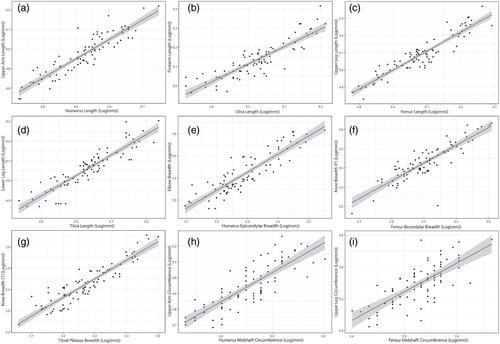Quantifying the relationship between bone and soft tissue measures within the rhesus macaques of Cayo Santiago
Abstract
Objectives
Interpretations of the primate and human fossil record often rely on the estimation of somatic dimensions from bony measures. Both somatic and skeletal variation have been used to assess how primates respond to environmental change. However, it is unclear how well skeletal variation matches and predicts soft tissue. Here, we empirically test the relationship between tissues by comparing somatic and skeletal measures using paired measures of pre- and post-mortem rhesus macaques from Cayo Santiago, Puerto Rico.
Materials and Methods
Somatic measurements were matched with skeletal dimensions from 105 rhesus macaque individuals to investigate paired signals of variation (i.e., coefficients of variation, sexual dimorphism) and bivariate codependence (reduced major axis regression) in measures of: (1) limb length; (2) joint breadth; and (3) limb circumference. Predictive models for the estimation of soft tissue dimensions from skeletons were built from Ordinary Least Squares regressions.
Results
Somatic and skeletal measurements showed statistically equivalent coefficients of variation and sexual dimorphism as well as high epiphyses-present ordinary least square (OLS) correlations in limb lengths (R2 >0.78, 0.82), joint breadths (R2 >0.74, 0.83) and, to a lesser extent, limb circumference (R2 >0.53, 0.68).
Conclusion
Skeletal measurements are good substitutions for somatic values based on population signals of variation. OLS regressions indicate that skeletal correlates are highly predictive of somatic dimensions. The protocols and regression equations established here provide a basis for reliable reconstruction of somatic dimension from catarrhine fossils and validate our ability to compare or combine results of studies based on population data of either hard or soft tissue proxies.



 求助内容:
求助内容: 应助结果提醒方式:
应助结果提醒方式:


